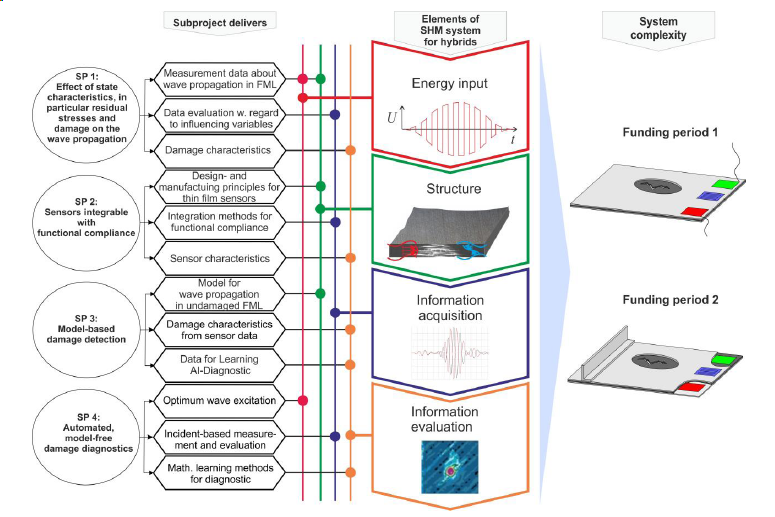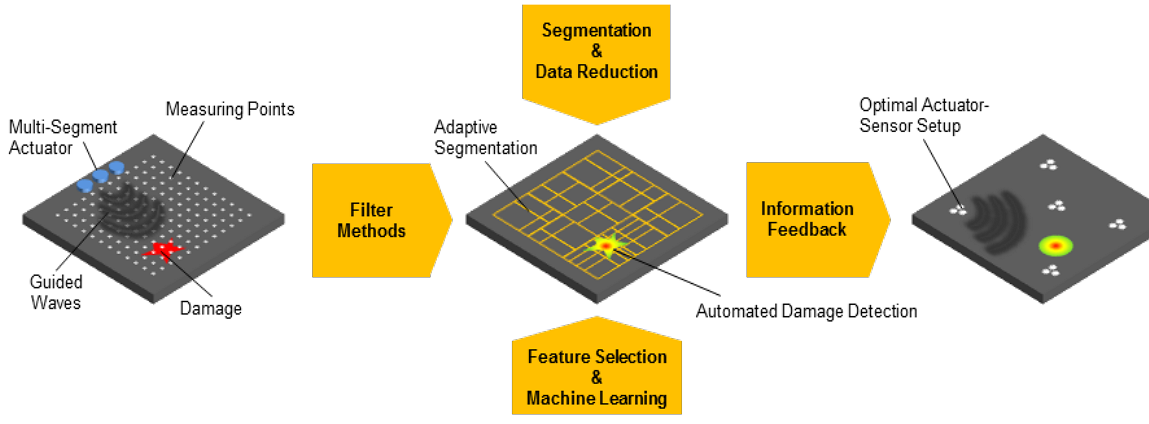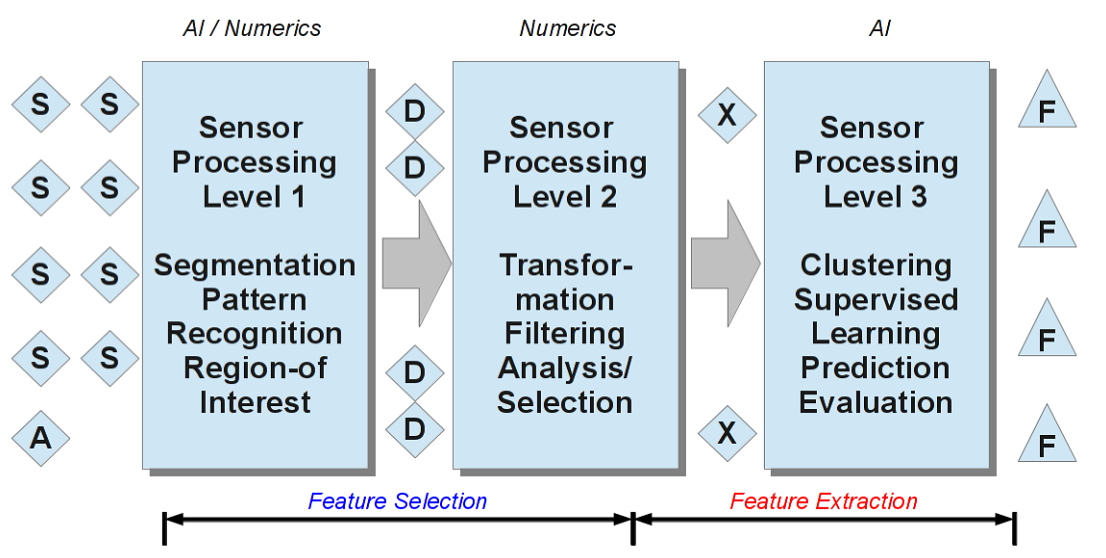 Universität Koblenz - Praktische Informatik
Universität Koblenz - Praktische Informatik
 Universität Koblenz - Praktische Informatik
Universität Koblenz - Praktische Informatik

Ultrasonic Monitoring of Fibre Metal Laminates Using Integrated Sensors
The aim of the Research Unit FOR3022 is to gain a profound understanding of an integrated Structural Health Monitoring (SHM) in Fibre Metal Laminates (FML) using guided ultrasonic waves in an interdisciplinary collaboration of material scientists, computer scientists, and mathematicians. This requires an integral view on the physical phenomena of wave propagation even under complex environmental conditions, their interaction with hidden damage, recording of these interactions using micro-technical sensors at the location of event, and a signal processing for full damage diagnostics utilising artificial intelligence methods. The findings will be useful for the consideration and comprehensive understanding of wave propagation in all layered material systems made from components of large impedance differences.
The research unit addresses interdisciplinary research in:

The subprojects (SP) pursue the following research hypothesis:
In this subproject, methods and algorithms for automated and model-free damage diagnostics of fibre metal laminates using Guided Ultrasonic Waves (GUW) are investigated. For this purpose, high-dimensional (with respect to spatial and temporal dimensions), experimental and simulated sensor data (form single point sensor sources and two-dimensional scanned images) are used as the starting point and analysed in a segmented manner.
Spatially and temporally high-resolution air-coupled ultrasonic measuring and scanning techniques are used for the investigation of damage detection in Fibre Metal Laminates (FML).
This high-dimensional sensor data is handled as a virtual distributed large-scale sensor network, to enabling the investigation of distributed and segmented algorithms suitable for Non- Destructive Testing (NDT) and Structural Health Monitoring (SHM). The resulting high number of data is to be reduced by an automated and segmented feature selection and extraction process, i.e., segmented local prediction and global fusion of local feature extraction and prediction.
The final extraction of robust damage information is achieved through Machine Learning (ML), agent-based approaches, and data mining combined with wave number filter (see conceptual overview of the SP4 in Figure 1). Finally, feedback of this information provides a deeper understanding of robust damage features in the wave propagation and thus, the actuator-sensor configurations can be optimal adapted to the ML approaches.
 Figure 1. Overview of SP4 – from high-resolution sensor data to automated damage detection based on ML with optimal adapted actuator-sensor configuration
Figure 1. Overview of SP4 – from high-resolution sensor data to automated damage detection based on ML with optimal adapted actuator-sensor configuration
There are several different techniques that can be applied for automatic feature selection providing data reduction, i.e., Region-of-interest (ROI) detection of sensor data (sensor amplification), clustering for unsupervised damage classification, and hybrid supervised ML architectures for robust damage classification. Finally, a paradigm shift from spatially global to local sensor data processing is performed.
The overall objective of the whole research unit is to gain a thorough understanding of an integrated system for Structural Health Monitoring in laminates with layers of large impedance difference, especially fibre metal laminates, using GUW. The aim of this subproject is to investigate a novel, model-independent approach to damage diagnostics based on ML techniques in order to gain a deeper understanding of the damage interaction of guided waves in FML and to classify different types of damages with an optimal adapted measurement system.
The ML techniques require as input high dimensional data sets of guided wave fields with different damage types and damage positions as well as spatially and temporally high- resolution sensor data. Due to different wave interactions of guided wave modes with damages the data sets must include different setups where single guided wave modes are amplified and emitted to specific regions of the plate structure. The data sets consist of guided wave field at various frequencies which are experimentally recorded over the 2D plate surface using aircoupled ultrasonic techniques.
Within the experimental measurements different damage types and positions are realized by removable pseudo damages. In order to have autonomy over the predominated guided wave mode and its propagation direction, multi-segment piezoceramic actuators are applied on the FML plates that can be controlled with phase shift. On the sensor side the wave propagation of single guided waves modes can be extracted by data pre- processing where wave number and propagation direction filters in the wave number domain are applied.
These techniques of the measurement system enable to amplify the wave interaction mechanism (absorption, reflection, scattering or mode conversion) of different guided wave modes with damages and positively support the classification of damages by ML methods.
The damage diagnostic of the high dimensional data sets has a modular structure and is composed of three different layers. The layers enabling the automated and robust data reduction of high-dimensional sensor data, the automated and robust sensor data feature selection and computation, and the automated identification of Regions Of Interest (ROI) with high information gain for automated and expert-driven damage analysis. This finally results in an improvement of the measuring quality by a feedback loop coupling predictors and classifiers with parameterisable measurement systems.
Fusion of model-based methods (inverse numeric) and model-free probabilistic methods (machine learning) should improve overall detection quality of damages and inhomogeneities. The concept of multi-layer learning architectures should be evaluated to enable learner of learners combining non-destructive testing like computer tomography (using measuring data for automated labelling and training) and ultrasonic measuring methods (using sensor data for classification).
This subproject will investigate multi-layered and hybrid data processing (Data Mining) architecture consisting of sensor data pre-processing, feature selection (selection of appropriate sensor data variables), and feature extraction (information mining and prediction of damages and inhomogenities), summarized in Figure 2. The layers are investigated in different cooperative work packages.
 Figure 2. Three-layer Architecture combining numerics and AI (1) Pre-processing, spatial and temporal
segmentation and selection of ROI (2) Sensor Data Feature Selection (3) Damage/Inhomogenity
Information Feature Extraction [S: Raw Sensor Data, A: Annotated Data, D: Pre-selected Data, X: Pre-
processed and reduced Data, F: Features]
Figure 2. Three-layer Architecture combining numerics and AI (1) Pre-processing, spatial and temporal
segmentation and selection of ROI (2) Sensor Data Feature Selection (3) Damage/Inhomogenity
Information Feature Extraction [S: Raw Sensor Data, A: Annotated Data, D: Pre-selected Data, X: Pre-
processed and reduced Data, F: Features]
Finally, the result of ML based damage diagnostic is feedback to the individual parameters of the measurement system in order to derive design rules of optimal actuator-sensor setup, which is necessary for the later, in the 2nd funding period investigated, SHM system. Therefore the extracted damage features of ML are interpreted in terms of wave interaction parameters with damages, such as attenuation, reflection or mode conversion.
Out of this interpretation the parameters of the actuator-sensor setup can be optimized so that the damage features can be amplified and a robust detection of different damage types is ensured. The aim is to develop an actuator-sensor system which is specially tuned and optimized to the damage features of the ML techniques.
We postulate the following hypotheses:
The combination of automatic, adaptive and segmented feature extraction and machine learning techniques with guided wave based SHM techniques enables automated inspection of FML for damage detection.